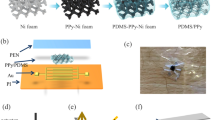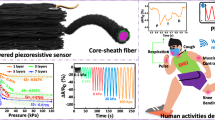Abstract
Three-dimensional (3D) porous piezoresistive sensors are widely used because of their simple fabrication and convenient signal acquisition. However, because of the dependence on organic skeleton materials and the complexity of conductive coating preparation, the electrical and mechanical properties of 3D wearable piezoresistive sensors have gradually failed to accommodate many emerging fields. Here, a new flexible 3D piezoresistive sensor (NF3PS) with high sensitivity and a wide measurement range is proposed, which comprises a natural porous loofah as a flexible framework and carbon fiber/carbon nanotube (CF/CNT) multiscale composite as a conductive coating. Composed of cellulose and lignin, the irregular, porous loofah has excellent mechanical strength, elasticity, and toughness, ensuring a repeated compression/recovery behavior of the NF3PS. In addition, compared with the single-size carbon coating, the coupling of multiscale CF/CNT composite coating improves sensitivities over a range of pressures. The NF3PS demonstrates a sensitivity of 6.94 kPa−1 with good linearity in the pressure range of 0–11.2 kPa and maintains a sensitivity of 0.28 kPa 1 in an ultrawide measurement range of 11.2–84.6 kPa. Considering flexibility, robustness, and wide-ranging linear resistance variation, the feasibility of the NF3PS in human activity monitoring, mechanical control, and smart homes is verified. This work provides a novel strategy for a new generation of 3D flexible pressure sensors for improving sensitivity and measurement range and demonstrates attractive applications in wearable sensors.
Similar content being viewed by others
References
Yi Y, Wang B, Liu X, et al. Flexible piezoresistive strain sensor based on CNTs-polymer composites: A brief review. Carbon Lett, 2022, 32: 713–726
Ma L, Xia T, Yu R, et al. A 3D-printed, sensitive, stable, and flexible piezoresistive sensor for health monitoring. Adv Eng Mater, 2021, 23: 2100379
Zhou H, Zheng L, Meng Q, et al. A flexible hydrogel tactile sensor with low compressive modulus and dynamic piezoresistive response regulated by lignocellulose/graphene aerogels. J Mater Chem C, 2021, 9: 12895–12903
Gong Y, Cheng X, Wu Z, et al. A flexible tactile sensor array for dynamic triaxial force measurement based on aligned piezoresistive nanofibers. IEEE Sens J, 2021, 21: 21989–21998
Liu H, Chen X, Zheng Y, et al. Lightweight, superelastic, and hydrophobic polyimide nanofiber/MXene composite aerogel for wearable piezoresistive sensor and oil/water separation applications. Adv Funct Mater, 2021, 31: 2008006
Georgopoulou A, Michel S, Clemens F. Sensorized robotic skin based on piezoresistive sensor fiber composites produced with injection molding of liquid silicone. Polymers, 2021, 13: 1226
Yang T, Deng W, Chu X, et al. Hierarchically microstructure-bioinspired flexible piezoresistive bioelectronics. ACS Nano, 2021, 15: 11555–11563
Hou X J, Zhong J X, He J, et al. Porous fiber paper and 3D patterned electrodes composed high-sensitivity flexible piezoresistive sensor for physiological signal monitoring. Sci China Tech Sci, 2022, 65: 1169–1178
Huang L, Chen J, Xu Y, et al. Three-dimensional light-weight piezoresistive sensors based on conductive polyurethane sponges coated with hybrid CNT/CB nanoparticles. Appl Surf Sci, 2021, 548: 149268
Wang X, Li H, Wang T, et al. Flexible and high-performance piezoresistive strain sensors based on multi-walled carbon nanotubes@polyurethane foam. RSC Adv, 2022, 12: 14190–14196
Nabeel M, Varga M, Kuzsela L, et al. Preparation of bamboo-like carbon nanotube loaded piezoresistive polyurethane-silicone rubber composite. Polymers, 2021, 13: 2144
Ke K, Sang Z, Manas-Zloczower I. Hybrid systems of three-dimensional carbon nanostructures with low dimensional fillers for piezoresistive sensors. Polym Compos, 2020, 41: 468–477
Lei X, Ma L, Li Y, et al. Highly sensitive and wide-range flexible pressure sensor based on carbon nanotubes-coated polydimethylsiloxane foam. Mater Lett, 2022, 308: 131151
Herren B, Charara M, Saha M C, et al. Rapid microwave polymerization of porous nanocomposites with piezoresistive sensing function. Nanomaterials, 2020, 10: 233
Yu T, Zhang D, Wu Y, et al. Graphene foam pressure sensor based on fractal electrode with high sensitivity and wide linear range. Carbon, 2021, 182: 497–505
Davoodi E, Montazerian H, Haghniaz R, et al. 3D-printed ultra-robust surface-doped porous silicone sensors for wearable biomonitoring. ACS Nano, 2020, 14: 1520–1532
Han X, Lv Z, Ran F, et al. Green and stable piezoresistive pressure sensor based on lignin-silver hybrid nanoparticles/polyvinyl alcohol hydrogel. Int J Biol Macromolecules, 2021, 176: 78–86
Shen J, Guo Y, Zuo S, et al. A bioinspired porous-designed hydrogel@polyurethane sponge piezoresistive sensor for human-machine interfacing. Nanoscale, 2021, 13: 19155–19164
Zhang H, Liu N, Shi Y, et al. Piezoresistive sensor with high elasticity based on 3D hybrid network of sponge@CNTs@Ag NPs. ACS Appl Mater Interfaces, 2016, 8: 22374–22381
Ding L, Zhang L, Zhang S, et al. Highly sensitive piezoresistive sensor based on modified polystyrene microsphere multi-layer stacking conductive interface. Chem Lett, 2019, 48: 1206–1208
Charara M, Luo W, Saha M C, et al. Investigation of lightweight and flexible carbon nanofiber/poly dimethylsiloxane nanocomposite sponge for piezoresistive sensor application. Adv Eng Mater, 2019, 21: 1801068
Zhai W, Xia Q, Zhou K, et al. Multifunctional flexible carbon black/polydimethylsiloxane piezoresistive sensor with ultrahigh linear range, excellent durability and oil/water separation capability. Chem Eng J, 2019, 372: 373–382
Kim K, Choi J, Jeong Y, et al. Highly sensitive and wearable liquid metal-based pressure sensor for health monitoring applications: integration of a 3D-printed microbump array with the microchannel. Adv Healthcare Mater, 2020, 9: 2000313
Chen S, Luo J, Wang X, et al. Fabrication and piezoresistive/piezoelectric sensing characteristics of carbon nanotube/PVA/nano-Zno flexible composite. Sci Rep, 2020, 10: 8895
Yang C, Liu W J, Liu N, et al. Graphene aerogel broken to fragments for a piezoresistive pressure sensor with a higher sensitivity. ACS Appl Mater Interfaces, 2019, 11: 33165–33172
Daňová R, Olejnik R, Slobodian P, et al. The piezoresistive highly elastic sensor based on carbon nanotubes for the detection of breath. Polymers, 2020, 12: 713
Tewari A, Gandla S, Bohm S, et al. Highly exfoliated MWNT-rGO ink-wrapped polyurethane foam for piezoresistive pressure sensor applications. ACS Appl Mater Interfaces, 2018, 10: 5185–5195
Yang Z, Li H, Zhang S, et al. Superhydrophobic MXene@carboxylated carbon nanotubes/carboxymethyl chitosan aerogel for piezoresistive pressure sensor. Chem Eng J, 2021, 425: 130462
Tang Z, Jia S, Zhou C, et al. 3D printing of highly sensitive and large-measurement-range flexible pressure sensors with a positive piezoresistive effect. ACS Appl Mater Interfaces, 2020, 12: 28669–28680
Zhao X, Wang W, Wang Z, et al. Flexible PEDOT:PSS/polyimide aerogels with linearly responsive and stable properties for piezoresistive sensor applications. Chem Eng J, 2020, 395: 125115
Fortunato M, Bellagamba I, Tamburrano A, et al. Flexible Ecoflex®/graphene nanoplatelet foams for highly sensitive low-pressure sensors. Sensors, 2020, 20: 4406
Cui T, Yang L, Han X, et al. A low-cost, portable, and wireless in-shoe system based on a flexible porous graphene pressure sensor. Materials, 2021, 14: 6475
Li W, Jin X, Han X, et al. Synergy of porous structure and microstructure in piezoresistive material for high-performance and flexible pressure sensors. ACS Appl Mater Interfaces, 2021, 13: 19211–19220
Zhu M, Li J, Yu J, et al. Superstable and intrinsically self-healing fibrous membrane with bionic confined protective structure for breathable electronic skin. Angew Chem Int Ed, 2022, 61: e202200226
Zhu M, Wang Y, Lou M, et al. Bioinspired transparent and antibacterial electronic skin for sensitive tactile sensing. Nano Energy, 2021, 81: 105669
Ding X, Zhong W, Jiang H, et al. Highly accurate wearable piezoresistive sensors without tension disturbance based on weaved conductive yarn. ACS Appl Mater Interfaces, 2020, 12: 35638–35646
Zhu M, Lou M, Yu J, et al. Energy autonomous hybrid electronic skin with multi-modal sensing capabilities. Nano Energy, 2020, 78: 105208
Wang Y, Zhu M, Wei X, et al. A dual-mode electronic skin textile for pressure and temperature sensing. Chem Eng J, 2021, 425: 130599
Author information
Authors and Affiliations
Corresponding author
Additional information
This work was supported by the National Natural Science Foundation of China (Grant No. 52175554), the Natural Science Foundation of Hebei Province (Grant No. F2021409007), the Hebei Province Foundation for the Returned Overseas Chinese Scholars (Grant No. C20220103), and the School Research Fund Project (Grant Nos. ZDYY-2021-01, YKY-2022-33).
Electronic Supplementary Material
Supplementary material, approximately 1.12 MB.
Supplementary material, approximately 4.30 MB.
Rights and permissions
About this article
Cite this article
Zhu, J., Song, Y., Xue, X. et al. An eco-friendly and highly sensitive loofah@CF/CNT 3D piezoresistive sensor for human activity monitoring and mechanical cotrol. Sci. China Technol. Sci. 65, 2667–2674 (2022). https://doi.org/10.1007/s11431-022-2204-2
Received:
Accepted:
Published:
Issue Date:
DOI: https://doi.org/10.1007/s11431-022-2204-2




